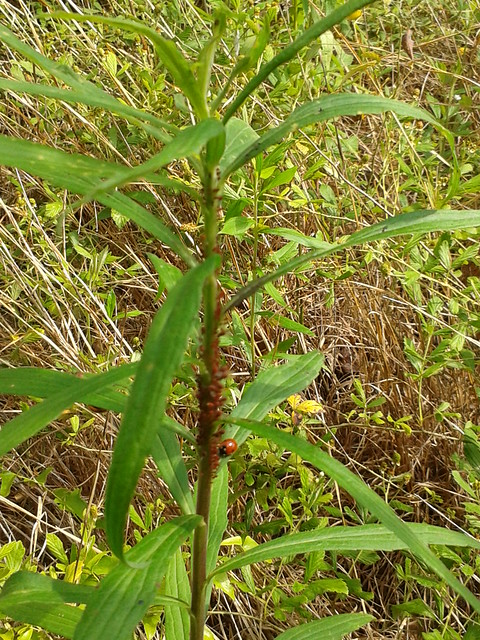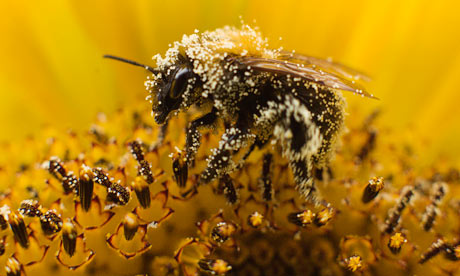Yum!

Picture by John S. Quarterman for Okra Paradise Farms, Lowndes County, Georgia, 16 May 2013.
-jsq
 How long will it take the U.S. to follow Europe’s ban of
neonicotinoid pesticides, putting health of bees and food crop pollination
ahead of corporate profit?
How long will it take the U.S. to follow Europe’s ban of
neonicotinoid pesticides, putting health of bees and food crop pollination
ahead of corporate profit?
Damian Carrington wrote for the Guardian today, Bee-harming pesticides banned in Europe: EU member states vote ushers in continent-wide suspension of neonicotinoid pesticides,
Europe will enforce the world’s first continent-wide ban on widely used insecticides linked to serious harm in bees, after a European commission vote on Monday.
The landmark suspension is a victory for millions of environment campaigners concerned about dramatic declines in bees who were backed by experts at the European Food Safety Authority (EFSA). But it is a serious defeat for the chemical companies who make billions a year from the products and also UK ministers—who voted against the ban. Both had argued the ban will harm food production.
The vote by the 27 member states of the European Union to suspend the insect nerve agents was supported by 15 nations, but did not reach the required majority under EU voting rules. The hung vote hands the final decision to the European commission (EC) who will implement the ban. “It’s done,” said an EC source.
-jsq
 Nature is not something
out there, apart from people.
It never was, and nowadays people have built and farmed and clearcut
so much that wildlife species from insects to birds are in trouble.
In south Georgia people may think that our trees make a lot of wildlife habitat.
Actually, most of those trees are planted pine plantations with
very limited undergrowth, and in town many yards are deserts of grass
plus exotic species that don’t support native birds.
Douglas Tallamy offers one solution:
turn yards into wildlife habitat by growing native species.
Since we are as always remodeling nature, we might as well do it
so as to feed the rest of nature and ourselves,
and by the way get flood prevention and possibly cleaner water as well,
oh, and fewer pesticides to poison ourselves.
Nature is not something
out there, apart from people.
It never was, and nowadays people have built and farmed and clearcut
so much that wildlife species from insects to birds are in trouble.
In south Georgia people may think that our trees make a lot of wildlife habitat.
Actually, most of those trees are planted pine plantations with
very limited undergrowth, and in town many yards are deserts of grass
plus exotic species that don’t support native birds.
Douglas Tallamy offers one solution:
turn yards into wildlife habitat by growing native species.
Since we are as always remodeling nature, we might as well do it
so as to feed the rest of nature and ourselves,
and by the way get flood prevention and possibly cleaner water as well,
oh, and fewer pesticides to poison ourselves.
Douglas Tallamy makes a clear and compelling case in
 Bringing Nature Home: How You Can Sustain Wildlife with Native Plants
Bringing Nature Home: How You Can Sustain Wildlife with Native Plants
…it is not yet too late to save most of the plants and animals that sustain the ecosystems on which we ourselves depend. Second, restoring native plants to most human-dominated landscapes is relatively easy to do.
Some of you may wonder why native species are so important? Don’t we have more deer than we can shoot? Maybe so, but we have far fewer birds of almost every species than we did decades and only a few years ago.
Some may wonder: aren’t exotic species just as good as native ones,
if deer and birds can eat them?
Actually, no, because many exotic species are poisonous
 to native wildlife, and because invasive exotics crowd out natives
and reduce species diversity.
From kudzu to
Japanese climbing fern, exotic invasives are bad for wildlife
and may also promote erosion and flooding by strangling native vegetation.
to native wildlife, and because invasive exotics crowd out natives
and reduce species diversity.
From kudzu to
Japanese climbing fern, exotic invasives are bad for wildlife
and may also promote erosion and flooding by strangling native vegetation.
All plants are not created equal, particularly in their ability to support wildlife. Most of our native plant-eaters are not able to eat alien plants, and we are replacing native plants with alien species at an alarming rate, especially in the suburban gardens on which our wildlife increasingly depends. My central message is that unless we restore native plants to our suburban ecosystems, the future of biodiversity in the United States is dim.
Tallamy had an epiphany when he and his wife moved to 10 acres in Pennsylvania in 2000:
Continue reading
Higher average temperatures
 mean much more frequent droughts and trees dying faster in droughts
because of the temperatures.
That plus pine beetles, according to research from 2009.
Forestry is Georgia’s second largest industry
in terms of
employment and wages and salaries,
more than $28 billion a year
according to the Georgia Forestry Commission,
plus an estimated
$36 billion a year in ecosystem services
such as water filtration, carbon storage, wildlife habitat, and aesthetics,
not to mention hunting and fishing.
Climate change matters to Georgia’s forests and to Georgia.
mean much more frequent droughts and trees dying faster in droughts
because of the temperatures.
That plus pine beetles, according to research from 2009.
Forestry is Georgia’s second largest industry
in terms of
employment and wages and salaries,
more than $28 billion a year
according to the Georgia Forestry Commission,
plus an estimated
$36 billion a year in ecosystem services
such as water filtration, carbon storage, wildlife habitat, and aesthetics,
not to mention hunting and fishing.
Climate change matters to Georgia’s forests and to Georgia.
The paper appeared 13 April 2009 in the Proceedings of the National Academy of the Sciences, Temperature sensitivity of drought-induced tree mortality portends increased regional die-off under global-change-type drought, by Henry D. Adams, Maite Guardiola-Claramonte, Greg A. Barron-Gafford, Juan Camilo Villegas, David D. Breshears, Chris B. Zou, Peter A. Troch, and Travis E. Huxman, 106(17) 7063-7066, doi: 10.1073/pnas.0901438106.

All drought trees in the warmer treatment died before any of the drought trees in the ambient treatment (on average 18.0 vs. 25.1 weeks, P <0.01; Fig. 1A).
They say warmer trees dying faster in drought wasn’t due to a difference in amount of water. Instead, they infer the warmer trees couldn’t breathe.
Combined, our results provide experimental evidence that piñon pines attempted to avoid drought-induced mortality by regulating stomata and foregoing further photosynthesis but subsequently succumbed to drought due to carbon starvation, not sudden hydraulic failure. Importantly, we isolate the effect of temperature from other climate variables and biotic agents
and show that the effect of warmer temperature in conjunction with drought can be substantial.
Our results imply that future warmer temperatures will not only increase background rates of tree mortality (13, 16), but also result in more frequent widespread vegetation die-off events (3, 35) through an exacerbation of metabolic stress associated with drought. With warmer temperatures, droughts of shorter duration—which occur more frequently—would be sufficient to cause widespread die-off.
How much more frequently?
They calculated an estimate for that, too: five times more frequently.
Of course, that’s for the specific kinds of forests they were studying,
and the exact number may vary, but the general trend is clear:
higher temperatures mean more frequent droughts,
like
 the year-long drought we just experienced in south Georgia.
the year-long drought we just experienced in south Georgia.

This projection is conservative because it is based on the historical drought record and therefore does not include changes in drought frequency, which is predicted to increase concurrently with warming (2, 37—39). In addition, populations of tree pests, such as bark beetles, which are often the proximal cause of mortality in this species and others, are also expected to increase with future warming (7, 9, 38).
Bark beetles, such as the ones that bored into this 19 inch slash pine
and spread from there to twenty others I had to cut down to prevent further spread
of the pine beetles.
What happens when pine beetles spread
is what you see in the
first picture in this post:
acres and acres of dead red pine trees.
 Monoculture slash pine plantations may show this effect most clearly,
but look around here, and you’ll see red dead loblolly and longleaf pines,
too.
Monoculture slash pine plantations may show this effect most clearly,
but look around here, and you’ll see red dead loblolly and longleaf pines,
too.
The article is saying that if the beetles don’t get the trees weakened by droughts that will be much more frequent, the trees will die more quickly of suffocation, because the temperature is higher. Higher temperatures is something that should concern every Georgian in our state where forestry is the second largest industry and our forests protect our wildlife and the air that we breathe and the water that we drink.
-jsq
 Skeeterhawk says, “come get your okra at
Valdosta Farm Days today,
at the historic Lowndes County courthouse, corner of Patterson and Central!”
Skeeterhawk says, “come get your okra at
Valdosta Farm Days today,
at the historic Lowndes County courthouse, corner of Patterson and Central!”
Pictures and video by Gretchen Quarterman for Okra Paradise Farms, Lowndes County, Georgia, 26 September 2012.
-jsq
They move around pretty fast:
You can see pollen on the legs of the one on the right:
Here they are flying around:
Continue reading